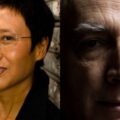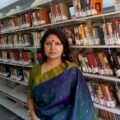Fluency, Fractures, and Fabrication in Cathy Park Hong
 photo by Harold Abramowitz
photo by Harold Abramowitz
The language spoken in the Desert is an amalgamation of some 300 languages and dialects imported into this country, a rapidly evolving lingua franca. The language, while borrowing the inner structures of English grammar, also borrows from existing and extinct English dialects and other languages. In the Desert, civilian accents morph so quickly that their accents betray who they talked to that day rather than their cultural roots. Fluency is also a matter of opinion. There is no tuning fork to one’s twang. Still, dialects differ greatly depending on region.
Fluency is a tricky and precarious state. It shares with water both its etymology and its characteristics: fluent speech flows freely, with few, if any, hesitations or gaps. But it is difficult to pinpoint what exactly produces fluency. There’s a social and political aspect to it. Not only must you understand the language, but others must also understand your speech. They must also assess you as fluent—a process complicated by racial, ethnic, and national issues. Fluency, in order to be fluency, must be recognized. Most importantly, perhaps, fluency is primarily in play when two or more languages are involved, as few people would ever think to claim they are fluent in their mother tongue. Rather, it is a property of the acquired language, and it can be lost or taken away.
In Cathy Park Hong’s second poetry collection, Dance Dance Revolution, the character of the Historian describes the complex and ever-shifting layers that make up the language of the Desert, a town that harkens back to Las Vegas in a world that feels post-apocalyptic. The Historian writes in our English, with familiar grammar, vocabulary, and spelling, and transcribes (and sometimes translates) phonetically the variant of the Desert language spoken by the Guide, who converses with tourists, migrants, and other civilians every day. Each character uses their intimate knowledge of the language—their fluency—in their own singular way.
In her debut collection, Translating Mo’um, Hong interrogates the way fluency, linguistic hybridity, and translation are produced in her depiction of futuristic worlds through dislocated idioms. The poet is no stranger to these issues herself. Hong’s writing resonates with the friction between Korean and English in her own consciousness. Her poetry wrestles with the fabric of language itself, chipping away at our linguistic norms and reflexes, exposing the rawness of the tongue beneath, connecting geographical topography and grammatical codes.
Rather than waxing poetic about polyglot minds and liminal or marginal identities, however, Hong dives into the crisscross of languages, disassembles them, and subjects them to new forms and new permutations. Whether constructing a new lingua franca based on a mishmash of tongues and wordplay or sieving language through the filter of Oulipian constraints, she uses language as a tool to explore the many implications of speech, and how it reflects the speaker’s inner life.
For example, take the first poem of Translating Mo’um, entitled “Zoo,” where Hong juxtaposes Korean and English phonetic properties and terms:
Alveolar tt, sibilant ss, and glottal hh
Shi: poem
Kkatchi: magpie
Ayi: child
Each column makes us think of a minimalistic poem, one where meaning must be found in the gaps, the untold connections, between a Romanized form of Korean on the left and its English translation on the right. Reduced to a single word, a translation may approximate the original, approaching asymptotically; but it never achieves equivalence. That may be why Hong uses the colon here rather than an equal sign. You may be fluent in both Korean and English, but still, transitions (dare I use the term translation?) between the two are strained. One does not easily flow from one language to another and back again, depending on the circumstance. Switching is a blindfold act, where one learns the contours of words on either side to decipher meaning within the silences.
This approach is heightened in Hong’s latest collection, Engine Empire, which weaves a narrative through the rugged Wild West to a Chinese boomtown and a futuristic landscape where the Internet has seemingly merged with our atmosphere in the form of smart snow. Many poems in the collection adhere to constraints lifted straight from the Oulipo handbook—lipograms and abecederians that push language to defy its apparent limitations. Hong’s gymnastic lipograms—a constraint that determines which letters can and cannot be used within the poem—are among the most visually striking works as well. They result in poems that use just one vowel, for example, such as the “Ballad in A,” which opens:
A Kansan plays cards, calls Marshall
a crawdad, that barb lands that rascal a slap;
that Kansan jackass scats,
camps back at caballada ranch.
These poems never reduce to mere exercises. The point is not to show off how nimble and clever the poetic voice can be, but to find out what language can endure while still producing meaning. Fluency first requires one to see language as a material that can take on an infinite number of shapes. As one grows versed in how to manage these shapes, one grows in fluency.
All throughout, Hong trains her sights on the political implications that accompany multilingualism and fluency. They are phenomena central to the histories of migrants, refugees, colonialism, multiculturalism. In Dance Dance Revolution the key figures are the Historian and the Guide. The former, a migrant from Sierra Leone, attended boarding schools in London, Hong Kong, and Connecticut; the latter, on the other hand, is a marginalized refugee, having fled South Korea after the Gwangju uprising in 1980. Both are ethnically mixed. The Historian (gender: unspecified) occupies an ambiguous position and works to construct a memoir, recording and piecing together (if not interpreting) the cultural context and the course of events. The Historian speaks and writes Standard English, explaining how to understand and translate the Desert language: standardizing this language structures and streamlines a complicated history as well.
By (apparent) contrast, the Guide is tied to a history of political unrest. She has become disillusioned, cynical, both with the possibility of revolution and with the powers that be. Her narrative—from revolutionary to refugee to tour guide—connects displacement and itinerary through the verbal cartography of the hotels and cities, replicas that lack the history of the originals. Speaking in her singular variation of the Desert language, the Guide’s voice is the most unstable. Her speech oscillates between biting political commentary on globalization, political upheaval, and colonialism, and reminiscences of her time in Korea. Her voice galvanizes the crowds, empowering her in her role as a guide, but doesn’t shy away from an underlying fickleness. For instance, she mentions, in “The Lineage of Yes-Men,” that she comes from a lineage of traitors: her father sold “Makkoli wine” and the “insurrectas” to the “whitey GIs,” and so did her grandfather, to the “Hapanese colonists.” In the course of her telling, she also fabricates her own shifting language out of whatever she can glean, from everything she hears. The Historian surmises:
I suspect that in the guide’s line of work, she gathers slang, idioms, and argot like data, appropriating them from other tour guides and tourists (which does not explain her use of the Middle English.).
In Romance languages, the etymology of fabricant indicates a maker, a manufacturer—one who creates something, pooling parts, stitching, welding, assembling a whole. In English, the word has more texture. A fabricated thing doesn’t ring true or honest. It belongs to the realm of make-believe.
In all three of her collections, Hong’s poetic voices are fabricants. They take apart and reassemble language, interrogate notions of reality and fiction, subvert any and all linguistic norms, bring about new forms of creation and invention. It’s above all a survival strategy. The characters in Hong’s poems are ostracized figures, pushed to the peripheries of meaning, from the “Hottentot Venus” and “Chang and Eng, the Original Siamese Twins” in Translating Mo’um all the way to the biracial (half Comanche) “Our Jim” in Engine Empire.
By fracturing language and countering linear, univocal narratives, Hong exposes the rifts within fractured consciousness. A composite identity makes for a composite text. Fluency here is not a matter of how well language flows, but of how easily one came move among different idioms and discourses, and how easily they can be subverted. The language in Hong’s poetry resists categorization as ornate vs. common vs. vulgar, polished vs. substandard, since those labels depend on an arbitrary hierarchy established as the norm through colonial and oppressive politics. Instead, the absolute right to a voice is asserted through attention to the power relations at work in words and silences:
What are the objects that turn me on: words—
han-gul: the language first used by female entertainers, poets, prostitutes.
Language that does not fit neatly into the canon syntaxes and narratives. Language that heralds a new kind of fluency in literature, one where the grit and cogs of words are exposed. Language aware of both centers and borders. Hong’s characters are another kind of fabricant as well: prophets, speech out of the wilderness, who insert the fractures of language back into the fundamental ambiguity of being human.
About AK Afferez
AK Afferez is a writer, translator, and sporadic blogger with a fondness for aliases (real name: Héloïse). Her work's been recognized both in France and in the United States. She currently lives in Lyon, France.





